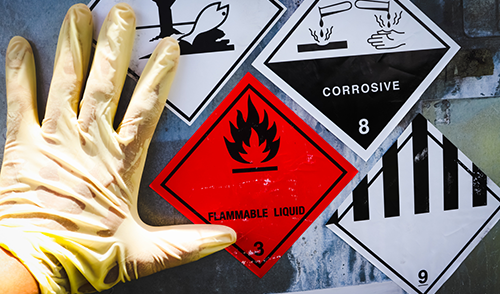Practitioner Resource Library

Welcome to our occupational health resource library for practitioners. Here, you'll find a wealth of information and tools designed to help promote health and safety in the workplace.
In this collection of resources, we cover a wide range of topics related to occupational health. From tips on how to prevent common workplace injuries to guidance on managing stress and maintaining work-life balance, our library has got you covered.
Our resource library is organized into the following categories: Online, Self-guided Training for Workers, Toolbox Talks, Hazard Alerts, and Resources for Veterans.
By viewing or using the materials listed below, you hereby agree to the terms and conditions of the Creative Commons Attribution Non-Commercial No Derivatives 4.0 License.
Email questions and comments to: supportiveworkplaces@ohsu.edu
Self-guided training for workers
At the Oregon Institute of Occupational Health Sciences, we offer free or low-cost training programs designed to improve workplace safety, health, and well-being within organizations.
Community of Practice and Support
Home care workers often lack access to training, ergonomic tools, and peer support, which puts them at greater risk of injuries and mental and physical illness. This evidence-based toolkit is geared toward creating a supportive community of professionals to help produce changes in safety and health outcomes. Home care workers, who typically work in isolated settings, have elevated injuries and health problems. The Community of Practice and Support (COMPASS) toolkit utilizes a peer-led social support group format designed to improve social well-being, reduce the risk of injuries, and promote health among home care workers. Home care workers learn together, set goals, and get support for making changes to advance safety, health and well-being.

Active Workplace toolkit
The Active Workplace toolkit is a program to help reduce sitting time at work and to provide training to help managers and supervisors better support workplace safety, health, and well-being for their employees. By reducing sedentary time and prolonged sitting at work, we can help improve worker health, safety, and well-being, reduce musculoskeletal pain, and reduce lost work time due to injury or illness.

Workplace resources
Toolbox Talks
The Oregon Fatality Assessment and Control Evaluation (OR-FACE) team has created Toolbox Talks, which highlight a particular safety issue and provide guidance on how to address the safety issue to prevent injuries and fatalities in the future. The toolbox talks are used to foster a group discussion that focuses on the safety issue at hand and can be used during safety meetings and/or at the start of a shift. Toolbox talks are available in English and Spanish and cover industries including construction, transportation, logging and forestry, and more.

Health Impacts Safety meeting guides
Health Impacts Safety are Total Worker Health® meeting guides on safety and health hazards. These guides are available to download for free. Each scripted guide takes approximately 10 to 15 minutes. Guides are intended to be used in a small to medium group setting, such as a safety or health committee meeting, toolbox meeting, or other team meetings. Use in conjunction with OR-FACE Toolbox Talks for an integrated safety, health, and well-being approach.

Hazard alerts
The Oregon Fatality Assessment and Control Evaluation (OR-FACE) team conducts surveillance, investigation, and assessment of traumatic occupational fatalities in Oregon, and produces safety materials to promote worker safety. They have created hazard alerts that highlight safety measures and provide guidance on how to address the hazard to prevent injuries or fatalities from a particular hazard. The hazard alerts use several similar case abstracts to draw attention to repeating fatal hazards.

Recursos en Español
El equipo de Evaluación y Control de Fatalidades de Oregon (OR-FACE) ha traducido algunas publicaciones al español. Estas publicaciones incluyen los Informes de Investigación, Charlas de Herramientas y Alertas de Peligro de OR-FACE. Obtenga más información sobre cada una de estas publicaciones a continuación.

Resources for veterans
The Study for Employment Retention of Veterans (SERVe) was funded by the U.S. Department of Defense to develop and evaluate the effects of the Veteran Supportive Supervisor Training (VSST) program. The research project was designed to make a positive difference in the lives of Oregon veterans and current service members by improving their experiences in their civilian workplaces. This series of one-page research profiles provides actionable behaviors that support the health and well-being of veterans and their families. The program ran from 2013-2018.
By viewing or using the Resources for veterans, you hereby agree to the terms and conditions of the Creative Commons Attribution Non-Commercial No Derivatives 4.0 License.
How does the perception of partner responsiveness relate to pain and sleep issues among military-connected couples?
Perceived Partner Responsiveness, Pain, and Sleep: A Dyadic Study of Military-Connected Couples
Comparisons between veterans separated from active duty, veterans separated from National Guard/Reserves and current active-duty National Guard/Reserves on work, health, and well-being outcomes.
National Guard/Reservists are Healthier than Post 9/11 Veterans
The impact of military sexual harassment and assault for women on symptoms of PTSD and social functioning impairment.
Military Sexual Trauma Among Women Veterans: The BufferingEffect of Coworker Support
Examination of drinking behaviors in service-connected individuals and their spouses/partners.
Dyadic Drinking Behaviors within Military-Connected Couples
Identifying current reservists and separated service members' motivations or reasons for drinking alcohol.
Current and Former U.S. Service Member Alcohol Ue and Drinking Motives
Identifying if the motivations for alcohol consumption are related to post-traumatic stress symptoms.
Post-traumatic Stress, Social Support, and Alcohol Consumption. Pros and Cons
Veteran Supportive Supervisor Training trains civilian supervisors to better support veterans.
Supervisor Support Training Contributes to Veteran Health and Work Outcomes
Uncovering critical supervisor behaviors that support veterans in the workplace.
Supportive Supervisor Behaviors for Employed Veterans
Veteran Supportive Supervisor Training trains civilian supervisors to improve family relationships.
Supportive Supervisor Training Improves Family Relationships Among Employee and Spouse Dyads
Uncovering critical supervisor behaviors that support veterans in the workplace.
Supportive Supervisor Behaviors for Employed Veterans
Veteran Supportive Supervisor Training trains civilian supervisors to improve family relationships.
Supportive Supervisor Training Improves Family Relationships Among Employee and Spouse Dyads
Supportive supervisor training to support the reintegration of veteran employees into the civilian workforce.
Training Supervisors to Support Reintegrating Veterans Improves Their Attitudes Toward Veteran Workers, which Enhances Worker Well-being
Supervisor support training improves employee positive emotions.
Supervisor Support Intervention and Employee Emotion
Learn more about our work

Newsletter
Explore professional development opportunities, the latest updates from the Oregon Healthy Workforce Center and the Occupational Public Health Program, a research snapshot, and upcoming occupational health-focused events.

Blog
The Oregon and the Workplace Blog features the latest from OccHealthSci research, professional development opportunities, and valuable insights from disciplines associated with occupational health, safety, and well-being.

Podcast
The What's Work Got to Do with It podcast, produced by OccHealthSci, brings together occupational health, safety, and well-being experts to discuss the latest topics relating to worker health, well-being, and safety in Oregon and beyond.
Contact us
Email questions and comments to: supportiveworkplaces@ohsu.edu